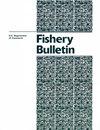Functional foraging habits and dietary overlap of yellowfin sole (Limanda aspera) and northern rock sole (Lepidopsetta polyxystra) in a coastal nursery of the Bering Sea: suppl. table
IF 0.8
4区 农林科学
Q3 FISHERIES
引用次数: 1
Abstract
2 Resource Assessment and Conservation Engineering Division Alaska Fisheries Science Center National Marine Fisheries Service, NOAA 7600 Sand Point Way NE, Building 4 Seattle, Washington 98115 3 Fisheries Behavioral Ecology Program Resource Assessment and Conservation Engineering Division Alaska Fisheries Science Center National Marine Fisheries Service, NOAA 2030 South Marine Science Drive Newport, Oregon 97165 Abstract—Understanding patterns of foraging and competition in nursery habitats can elucidate patterns of productivity in multispecies fisheries. Yellowfin sole (Limanda aspera) and northern rock sole (Lepidopsetta polyxystra) cooccur throughout the Bering Sea where they support major fisheries. We examined the diets and foraging ecology of juvenile yellowfin sole and northern rock sole (35–100 mm in standard length) captured along the north side of the Alaska Peninsula and in the Port MollerHerendeen Bay system, the largest marine embayment in the southeastern Bering Sea. As observed in other parts of their ranges, the diets of both species included polychaetes and amphipods. The primary difference in the diets of these species was that the prey of yellowfin sole were almost exclusively endobenthic and epibenthic invertebrates (>82.7% by weight combined) and the northern rock sole consumed substantial amounts of hyperbenthic mysids and pelagic euphausiids (42% combined). Overall dietary overlap was low (Schoener index [SI]=0.39), in part due to differences in microhabitat use. At sampling stations where both species cooccurred, dietary overlap was notably higher (SI=0.55). Patterns of functional foraging habits and juvenile niche separation that facilitate coexistence of these species throughout their range were expressed with a novel application of principal components analysis of the abiotic (habitat characteristics) and biotic (consumer traits) factors associated with commonly occurring prey types.白令海沿岸苗圃黄鳍比目鱼(Limanda aspera)和北岩比目鱼(Lepidopsetta polyxystra)的功能性觅食习性和饮食重叠。表格
2美国国家海洋渔业服务局阿拉斯加渔业科学中心资源评估与保护工程部,美国国家海洋渔业服务局阿拉斯加渔业科学中心资源评估与保护工程部,美国国家海洋渔业服务局,美国国家海洋渔业服务局,美国国家海洋渔业服务局,纽波特南海洋科学大道2030;了解苗圃栖息地的觅食和竞争模式可以阐明多物种渔业的生产力模式。黄鳍比目鱼(Limanda aspera)和北岩比目鱼(Lepidopsetta polyxystra)在整个白令海共同生长,在那里它们支持主要的渔业。我们研究了沿阿拉斯加半岛北侧和白令海东南部最大的海洋港湾moller - herendeen湾系统捕获的黄鳍鳎幼鱼和北岩鳎幼鱼(标准长度35-100毫米)的饮食和觅食生态。在它们活动范围的其他地方观察到,这两个物种的饮食包括多毛类和片脚类。这些物种的主要饮食差异是,黄鳍比目鱼的猎物几乎完全是底栖和底栖无脊椎动物(总重量为82.7%),而北岩比目鱼消耗大量的高底栖动物和中上层动物(总重量为42%)。总体饮食重叠度较低(Schoener指数[SI]=0.39),部分原因是微生境利用的差异。在两种物种共存的采样站,饮食重叠度明显较高(SI=0.55)。通过对与常见猎物类型相关的非生物(栖息地特征)和生物(消费者特征)因素的主成分分析,表达了促进这些物种在其整个范围内共存的功能性觅食习惯和幼崽生态位分离模式。
本文章由计算机程序翻译,如有差异,请以英文原文为准。
求助全文
约1分钟内获得全文
求助全文
来源期刊

Fishery Bulletin
农林科学-渔业
CiteScore
1.70
自引率
12.50%
发文量
76
审稿时长
>24 weeks
期刊介绍:
The quarterly Fishery Bulletin is one of the oldest and most respected fisheries journals in the world. It has been an official publication of the U.S. Government since 1881, under various titles, and is the U.S. counterpart to other highly regarded governmental fisheries science publications. It publishes original research and interpretative articles in all scientific fields that bear on marine fisheries and marine mammal science.
 求助内容:
求助内容: 应助结果提醒方式:
应助结果提醒方式:


